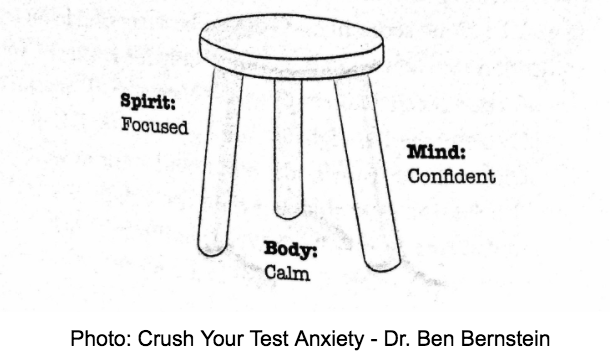Continuing our series about tips for Test Taking and Test Anxiety, we will be discussing how to Refocus and Stay Focused!
In our last blog, we discussed 3 ways to help combat test anxiety:
CALM our bodies, be CONFIDENT in our minds, and FOCUS.
Before we outline 3 Steps to Help you Stay Focused, we need to examine disconnection.
Disconnection is a way we cope with stress, as we disconnect or move away from our work or our goals. It can manifest in our mind, body, and spirit.
Disconnection…
- Of the body: may appear as lack of self-care, proper nutrition, and sleep.
- In the mind: may appear as negative self-talk.
- Of the spirit: may appear as breaking continuity and allowing distraction.
We’ll be focusing on this break in continuity and distraction as we detail strategies to STAY FOCUSED.

It is also important to note that the mind, body, and spirit are all connected. One model from Dr. Ben Bernstein describes this as the “three-legged stool”, where each leg – mind, body, and spirit – contribute to your total self and each leg plays a part in reducing stress and improving performance.
SETTING SPECIFIC GOALS AND IDENTIFYING DISTRACTION
In order to stay focused, it is often helpful to set specific goals. When setting these goals ask yourself:
- Why is this goal important?
- How am I going to get there?
- How can I break things up into manageable steps?
- Are my steps SMART? (Specific, measurable, adjustable, realistic, time-based)
Another thing to be aware of is what distracts you. Is it:
- Social media?
- Your friends?
- Noise?
- Feeling tired?
- Feeling anxious?
You can consult this list and use this worksheet to help identify distractions.
THREE STEPS FOR STAYING FOCUSED
Once you have set goals and identified what distracts you, the 3 Steps for Staying Focused can be applied more effectively.

- STOP – Stop and look at what you are doing, admit you are distracted, and stop barriers to your goal. Ask yourself, “Will this help me accomplish my goal?” and more often than not, the answer will be “No” and you can move to step 2!
- LISTEN – Listen to your inner voice! This may sound silly, but you know how to reach your goals, what steps to take to accomplish them, and how to get back on track. For example, if you are studying and you get a phone call, you may STOP and decide to return the call later, and then LISTEN to your inner voice saying, “Let’s review that last paragraph one more time before I move on.”
- FULFILL – Simply, this step means – ACT! Once you have stopped and identified distractions and listened to yourself as to how you should proceed, it is time to FULFILL this plan and act on it.
CONCLUSION
These steps can be applied as a student is studying, and especially during a test. Studying is a great time to practice these steps. Students can also avoid distractions by clearing their desks of physical distractions – their phones, loose papers, etc. – as well as other distractions, laptops, music, a TV on in the other room. During a testing situation, the 3 steps can be applied to help students stay focused on the task at hand – taking a test! Additionally, the steps will help a student stay present and may help them with anxiety during the test.
It is also important to note that these steps take practice! Students, be patient with yourselves! Keep at it! Parents and tutors, work with your student and encourage them to keep trying. Learning to focus effectively may take some time, but ultimately it will help students reach their goals.
[Adapted from Crush Your Test Anxiety by Dr. Ben Bernstein]

